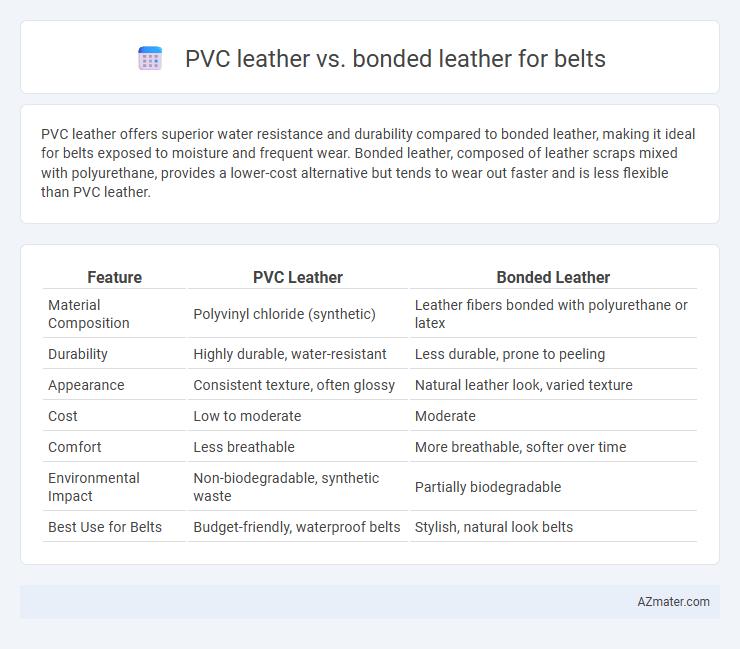PVC leather offers superior water resistance and durability compared to bonded leather, making it ideal for belts exposed to moisture and frequent wear. Bonded leather, composed of leather scraps mixed with polyurethane, provides a lower-cost alternative but tends to wear out faster and is less flexible than PVC leather.
Table of Comparison
| Feature | PVC Leather | Bonded Leather |
|---|---|---|
| Material Composition | Polyvinyl chloride (synthetic) | Leather fibers bonded with polyurethane or latex |
| Durability | Highly durable, water-resistant | Less durable, prone to peeling |
| Appearance | Consistent texture, often glossy | Natural leather look, varied texture |
| Cost | Low to moderate | Moderate |
| Comfort | Less breathable | More breathable, softer over time |
| Environmental Impact | Non-biodegradable, synthetic waste | Partially biodegradable |
| Best Use for Belts | Budget-friendly, waterproof belts | Stylish, natural look belts |
Introduction to Synthetic Leathers
PVC leather and bonded leather are two common types of synthetic leathers used in belt manufacturing, each offering distinct features. PVC leather is a durable, waterproof material made by coating a fabric base with polyvinyl chloride, providing a consistent texture and resistance to wear. Bonded leather, composed of leather scraps mixed with polyurethane and bonded onto a fiber sheet, offers a cost-effective alternative with a genuine leather appearance but lower durability compared to PVC leather.
What is PVC Leather?
PVC leather is a synthetic material made by coating a fabric base with polyvinyl chloride, offering durability and water resistance often preferred for belts. It mimics the texture and appearance of genuine leather while being more affordable and easier to maintain. Unlike bonded leather, which combines shredded leather fibers with adhesives, PVC leather provides a consistent surface less prone to peeling and cracking.
What is Bonded Leather?
Bonded leather is made by combining shredded leather fibers with polyurethane or latex binders, creating a material that mimics genuine leather at a lower cost. Unlike PVC leather, which is entirely synthetic and plastic-based, bonded leather contains actual leather content, but its durability and lifespan are generally lower due to the use of bonded scraps rather than full leather hides. For belts, bonded leather offers a balance between affordability and leather-like appearance, but it may show wear and peeling more quickly than PVC leather or genuine leather options.
Visual Differences Between PVC and Bonded Leather
PVC leather exhibits a uniform surface with a consistent grain pattern and often a glossy finish, enhancing its synthetic appearance on belts. Bonded leather features visible natural leather fibers compressed together, resulting in irregular texture and slight imperfections that give belts a more authentic look. The color of bonded leather belts tends to be richer and varies subtly, while PVC belts maintain a more artificial and flat coloration.
Durability: PVC Leather vs Bonded Leather
PVC leather exhibits superior durability compared to bonded leather due to its synthetic composition, which resists cracking, peeling, and stretching over time. Bonded leather, made by blending leather scraps with a polyurethane binder, tends to deteriorate faster, showing signs of flaking and weakening after extended use. For belt applications requiring long-lasting wear and structural integrity, PVC leather is the more reliable material choice.
Comfort and Flexibility Comparison
PVC leather belts offer greater flexibility due to their synthetic composition, allowing for a more adaptable fit and enhanced comfort during extended wear. Bonded leather, made from leather scraps bonded with adhesive, tends to be stiffer and less breathable, which can reduce comfort and limit flexibility over time. For belt users prioritizing softness and ease of movement, PVC leather provides a more comfortable experience compared to the relatively rigid nature of bonded leather.
Environmental Impact and Sustainability
PVC leather production involves significant environmental challenges due to its reliance on non-renewable petroleum-based materials and the release of toxic chemicals during manufacturing, contributing to pollution and non-biodegradability. Bonded leather consists of shredded genuine leather fibers mixed with polyurethane binders, which reduces waste by repurposing leather scraps but often includes synthetic components that hinder biodegradability and complicate recycling processes. Choosing between PVC leather and bonded leather for belts requires weighing the trade-offs between synthetic chemical pollution and the sustainable reuse of leather waste, with neither option offering fully sustainable solutions.
Price Comparison: Which is More Affordable?
PVC leather belts are generally more affordable than bonded leather belts due to lower production costs and synthetic materials involved. Bonded leather, made from leather scraps bonded together, tends to be pricier because it incorporates genuine leather fibers, offering a more authentic look and texture. Price differences can vary based on brand and craftsmanship, but PVC options consistently provide a budget-friendly choice for belt buyers.
Best Use Cases for Belts
PVC leather offers a durable, water-resistant surface ideal for belts used in casual or outdoor settings, providing long-lasting wear and easy maintenance. Bonded leather, made from leather scraps fused with adhesive, suits fashion belts that prioritize affordable style and a genuine leather appearance but are less durable for heavy daily use. For belts requiring frequent bending and stress, PVC leather's resistance to cracking makes it the superior choice, whereas bonded leather is best reserved for occasional or decorative wear.
Conclusion: Which Leather Should You Choose for Belts?
PVC leather offers superior water resistance and durability, making it an excellent choice for belts exposed to frequent moisture or rough use. Bonded leather provides a more natural appearance and softness but lacks the long-term resilience and strength needed for everyday wear. Choosing PVC leather ensures a longer-lasting, low-maintenance belt, while bonded leather suits those prioritizing aesthetic appeal and cost efficiency.

Infographic: PVC leather vs Bonded leather for Belt
 azmater.com
azmater.com